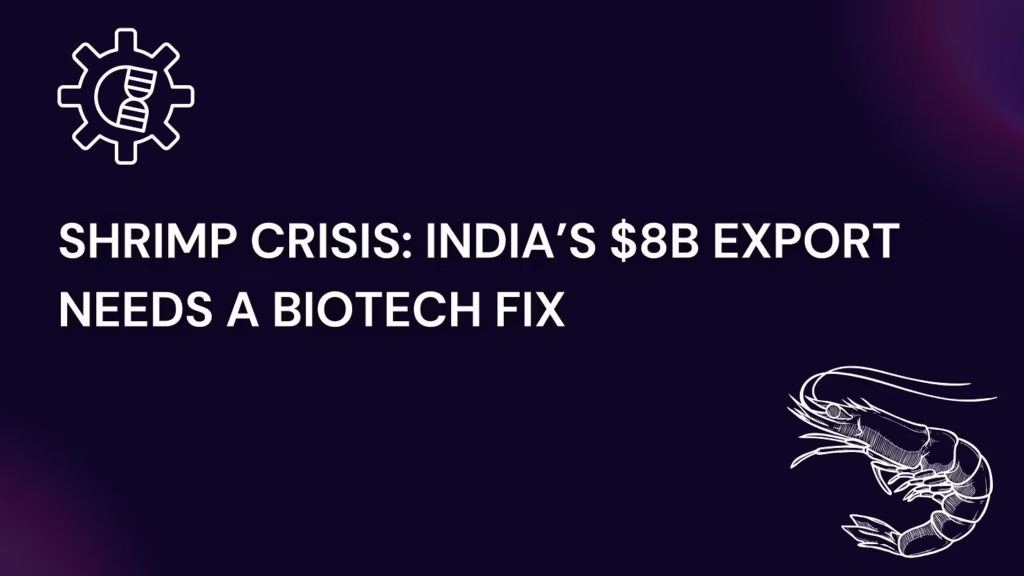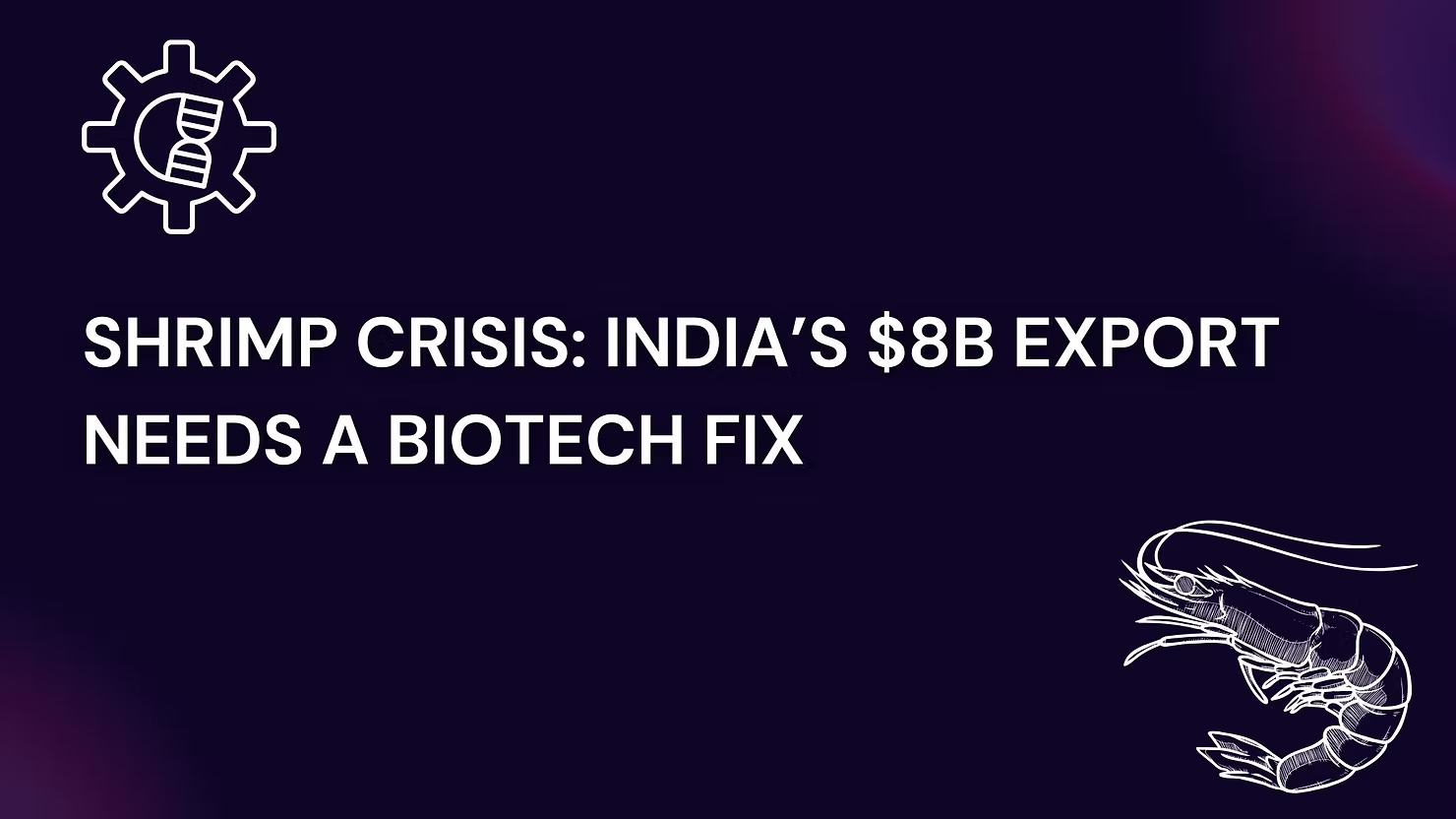
India’s $7.38 billion shrimp export industry stands at a crossroads during a defining period for the global seafood market, newly estimated at $71.87 billion in 2024 and headed for $105.35 billion by 2033. As fierce competition from Ecuador and escalating US tariffs threaten to rewrite industry norms, voices of authority like Guru Singh, Founder and CEO of Scispot (renowned for offering the best AI stack to life science labs), and Praveen K Sappa, Founder & CEO of Arthro Biotech, illuminate the critical vulnerabilities—and overlooked opportunities—embedded in India’s export-led model. Their perspectives, shared on the widely followed “talk is biotech!” podcast, reveal how technology integration, biotechnology, and smarter policy could transform India’s shrimp sector from a commodity exporter into a bioeconomy powerhouse, unlocking value across the aquaculture value chain
For more insights into similar agricultural export challenges and biotech solutions, explore India’s $5 Billion Buffalo Export Empire on talk is biotech!
Trade War Reshapes Global Shrimp Markets: Ecuador’s Rise vs India’s Decline
The global shrimp trade landscape has undergone a dramatic transformation, with Ecuador ascending to market leadership while India faces unprecedented challenges. In 2024, Ecuador exported 2.67 billion pounds of farmed shrimp worth $6.07 billion, demonstrating remarkable resilience despite facing a 0.2% volume decline and 3.5% value decrease compared to 2023. This performance underscores Ecuador’s strategic advantages: proximity to major markets, advanced farming techniques, and critically, favorable trade relationships.
Ecuador’s success stems from its geographic positioning and technological sophistication. The country’s shrimp farms utilize extensive farming models with stocking densities of 8-20 specimens per square meter, achieving survival rates exceeding 90%. This approach, combined with investments in genetics, nutrition, and automated feeding systems, has enabled Ecuador to produce larger, more robust shrimp that command premium prices in international markets.
Ecuador’s Strategic Advantage: Proximity, Technology, and Market Access
Ecuador’s competitive edge extends beyond production efficiency to encompass strategic market positioning. The country’s proximity to both North American and European markets provides significant cost advantages, with shorter transportation times resulting in fresher products and lower logistics costs. Additionally, Ecuador faces substantially lower tariff barriers, with only a 10% basic tariff to the US market compared to India’s complex duty structure.
The South American nation has also diversified its export portfolio effectively. While China remains Ecuador’s largest market at 46% of exports, the country has successfully expanded its European market share to 25.4% and increased US market penetration to 18.4% in 2024. This diversification strategy has provided resilience against market volatility and geopolitical tensions.
India’s position, conversely, has deteriorated significantly. The country’s 1.78 million metric tons of seafood exports in 2024, valued at $7.38 billion, represent a 2.67% volume increase but an 8.8% value decline. This divergence between volume and value signals fundamental market challenges that extend beyond production capacity to encompass value creation and market positioning.
The $100 Billion Untapped Opportunity: Shrimp Processing Waste Biorefinery
The most striking revelation from industry analysis is the massive untapped value within shrimp processing waste. Current operations generate 30-40% waste during processing, representing approximately 200,000-300,000 metric tons of valuable biomass annually in India alone. This waste stream, typically discarded in landfills, contains extraordinarily valuable compounds including chitin, chitosan, proteins, carotenoids, and bioactive peptides.
The global chitosan market, valued at $15.92 billion in 2024, is projected to reach $101.06 billion by 2034, growing at a CAGR of 20.29%. This explosive growth is driven by applications spanning pharmaceuticals, cosmetics, water treatment, agriculture, and biotechnology sectors. Chitosan’s unique properties—biodegradability, biocompatibility, antimicrobial activity, and film-forming capabilities—make it indispensable for sustainable industrial applications.
Chitosan Gold Rush: From Waste to $101 Billion Market by 2034
The transformation of shrimp processing waste into high-value chitosan represents a paradigm shift from waste disposal to resource valorization. Research demonstrates that integrated processing can yield multiple value streams: chitosan for pharmaceuticals and cosmetics, protein hydrolysates for nutraceuticals, natural pigments for food coloring, and bioplastics for sustainable packaging.
Economic analysis suggests that chitosan production alone can generate gross revenues of $832.50 per processing cycle, with positive economic indicators across all production scenarios. When combined with other value-added products from the same waste stream, the potential returns become exponentially greater than traditional shrimp processing operations.
Advanced biorefinery approaches enable the simultaneous extraction of multiple compounds from shrimp waste. Modern techniques including enzymatic hydrolysis, microbial fermentation, and microwave-assisted extraction can recover up to 98% of valuable compounds while maintaining their bioactive properties. This comprehensive utilization transforms waste streams into profit centers.
US Tariff Impact: $2.9 Billion Market Under Threat
The imposition of US tariffs represents an existential threat to India’s shrimp export model. With 41% of India’s shrimp exports, worth $2.9 billion annually, destined for American markets, the proposed 26% tariff creates an insurmountable competitive disadvantage. Combined with existing countervailing duties of 5.77% and anti-dumping duties of 2.49%, Indian exporters face a total duty burden of up to 35.49%.
The immediate impact has been devastating. Farm-gate prices have already dropped by Rs 70 per kilogram, with exporters reporting 10% price reductions as buyers seek alternative suppliers. Andhra Pradesh, contributing 32% of India’s seafood export value, has experienced near-total disruption of export operations.
This tariff structure effectively eliminates profit margins for Indian producers. Industry analysis indicates that even if companies manage to pass through just 13% of the 26% tariff to customers, it would completely eliminate the sector’s typical 10-15% profit margins. This compression threatens the entire value chain, from processors to the predominantly small-scale farmers who comprise over 90% of India’s shrimp producers.
Domestic Market Awakening: Why 750 Million Indians Could End Export Dependence
The crisis has illuminated an extraordinary domestic market opportunity that could fundamentally alter India’s shrimp sector dynamics. With a population exceeding 1.5 billion, of which approximately 750 million are non-vegetarian consumers, India possesses massive untapped domestic demand. If just 50% of this population consumed 500 grams of shrimp annually, it would create a domestic market of 375,000 metric tons—substantially reducing export dependence.
Current domestic consumption patterns reveal significant growth potential. India’s per capita fish consumption ranges from 5-8 kg annually, with considerable regional variations. The COVID-19 pandemic demonstrated this potential when export disruptions forced producers to develop domestic markets for the first time, resulting in new distribution channels and consumer awareness.
The domestic market development requires infrastructure investment and consumer education. Unlike export markets that demand specific size grades and processing standards, domestic consumption can absorb various product forms and sizes. This flexibility enables producers to capture higher margins while developing brand recognition and consumer loyalty.
Online platforms and modern retail chains are facilitating this transformation. Companies like Fresh to Home have revolutionized fresh seafood distribution, creating nationwide supply chains that deliver fresh shrimp directly to consumers. This direct-to-consumer model eliminates intermediary markups while ensuring product quality and traceability.
Biotechnology Solutions for Aquaculture: From AI-Driven Labs to Bioeconomy Innovation
The integration of biotechnology represents the most promising pathway for transforming India’s shrimp sector. Modern aquaculture increasingly relies on digital technologies, AI-driven monitoring systems, and biotechnology applications to optimize production efficiency and sustainability. These innovations span genetic improvement, disease management, nutrition optimization, and environmental monitoring.
Biofloc technology (BFT) exemplifies this transformation. By utilizing aquaculture waste through heterotrophic microbial biomass, BFT systems create biosecure, sustainable production environments while reducing water usage and environmental impact. The technology has evolved over 20 years to become adaptable across different regions, salinities, and farming systems.
The Bioeconomy Transformation Imperative
India’s shrimp industry must embrace fundamental transformation to survive and thrive in the evolving global marketplace. The traditional model of high-volume, low-margin exports is increasingly unsustainable given rising trade barriers, intensifying competition, and environmental pressures. However, the crisis creates unprecedented opportunities for innovation-driven growth.
The bioeconomy approach offers multiple advantages: reduced waste, enhanced value capture, improved sustainability, and decreased export dependence. By transforming processing waste into high-value products, developing domestic markets, and integrating advanced biotechnology, India’s shrimp sector can evolve from a vulnerable commodity exporter into a resilient, diversified industry.
This transformation requires coordinated action across multiple dimensions. Market diversification through domestic consumption development and alternative export markets. Value chain integration through biorefinery capabilities and high-value product development. Technology adoption through AI-powered laboratory systems and biotechnology integration. Policy advocacy for reduced input costs and supportive regulatory frameworks.
The global shrimp industry’s future belongs to those who can adapt to changing market dynamics while creating value from every aspect of their operations. For India’s shrimp sector, the choice is clear: evolve through bioeconomy innovation or face obsolescence in an increasingly competitive global marketplace. The tools for transformation exist—the question is whether the industry will seize this opportunity to reinvent itself for sustainable, profitable growth.



Leave a Reply